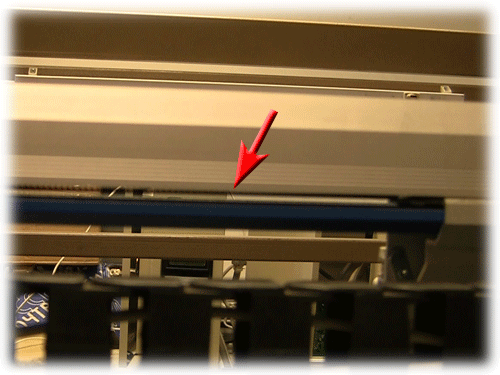Home / Products / Advantages of SAUNO machines / Precision mechanics
High precision ball screw drives.

Modern engraving equipment market offers machines of various models. At first glance, they all look somewhat similar to each other, but in fact, each machine has a diffrent construction design.
When developing our machines, SAUNO company analyzed various types of drives.
We did not reduce the cost of our equipment by using cheap mechanical components in its assembly.
Small savings in cost, result in the inability to achieve good quality results and the need for frequent adjustments.

Problems in the operation of machine drives affect the quality of engraving. The figure shows typical signs of deteriorating engraving quality: lines (1), missing lines (2), stripes (3), offset lines, uneven edges (4).
It is important to note that in the case of low accuracy of machine drives, defects affecting engraving cannot be eliminated by adjusting or repairing machine components.
SAUNO company uses only German-made ball screw drives (ball screws) in its machines.
For more than twenty-five years of operation in engraving workshops around the world, our machines have proven themselves to be accurate, reliable and durable due to their first-class mechanics.
Let's compare the ball screw drive used in SAUNO machines with the other types of drives, namely a belt drive and a rack drive.
Belt drive
Belt drive (black box - gear housing)
Belt runout during engraving
A belt drive uses an annular toothed belt stretched over two pulleys. The drive pulley is connected to the electric motor through a gearbox.
Disadvantages of belt drive:
- Belt drive is not recommended for use in dusty environments. Under the influence of stone dust, the belt loses elasticity, stretches and is subject to increased abrasion. The result is - deterioration in positioning accuracy and backlash in the drive.
- The stretching of the belt when it wears, causes beating in different speed ranges of the machine drive. The beats are transmitted to the engraving head and tool.
Conclusion - when working in a dusty environment, the belt drive is subject to accelerated wear. Periodic tension adjustment and/or belt replacement is required.
Rack drive
In a rack and pinion gear, the gear rotates and moves along the rack. In order to obtain the necessary precision of movement, a gearbox is usually used in a rack and pinion transmission.
Disadvantages of the rack drive:
- Low accuracy due to the presence of blacklash in the rack-pinion connection and in the gearbox gears.
- Backlash compensation using software correction methods, tilting the machine body or tension elements (elastic rubber, springs) is unreliable, since the amount of backlash tends to increase during operation. The need for manual adjustments reduces the reliability of the system.
Ball screw drive

Ball screw drive

Ball screw drives of the SAUNO machine.
Tension adjustment screw (1), wipers (2).
A ball screw drive (ball screw) consists of a screw and a nut with helical grooves-tracks in which dozens of balls are placed. The balls move along a closed path. The ball screw drive differs from a conventional screw drive in that the ball screw uses a rolling friction (balls) instead of sliding friction.
The advantages of the ball screw of the SAUNO machine include:
-Low friction losses, low wear, and therefore long service life.
-High accuracy and speed, smooth running, no beats.
-No backlash.
*It can be argued that over time, due to component wear, gaps and backlash appear in any screw drive.
In SAUNO machines, the ball screw drive has a special screw for adjusting the tension (see photo above).
To compensate for operational wear, simply tighten the screw slightly.
This adjustment is required infrequently - once every few years.
-Dust protection. Wipers protect the ball screw nut and balls from dust getting inside.
Linear guides of SAUNO machines
All engraving machines use guides of one design or another. The design of guides is an important condition for quality and reliability of operation.
Currently, SAUNO machines use linear guides with rolling bearings, the so-called. "slide blocks" (Fig. 1, 2).
Inside the bearings, as in ball screw drives, there are balls that help to reduce signifivantly ther friction and wear.
Linear guides with rolling bearings are high-precision, backlash-free and durable. Ball tension adjustment is provided.


Fig.1. Linear guide and slide block

Fig.2. Such guides work on SAUNO machines
On SAUNO machines of early modifications, various designs of linear guides were used, shown in Fig. 3..5.
We have abandoned this kind of technical solutions a long time ago, although some machines from other manufacturers still use such components today.

Fig.3. Bearing rolling on a guide

Fig.4. Roller bearings

Fig.5. Sliding friction guide
-Bearing rolling on a guide (Fig. 3) has low accuracy and is difficult to set up and adjust.
Dust contamination leads to bearing jamming, a sharp and uneven increase in friction, and deterioration in image quality.
In a dusty environment, the bearing gradually wears away the surface of the guide, which leads to an even greater wear.
- Roller bearings (Fig. 4) have low accuracy and blacklash.
Extremely difficult to set up and adjust. The slightest adjustment inaccuracy causes the drive to jam.
- Sliding friction guides (Fig. 5) do not have balls, and therefore wear out quickly, especially in dusty environments.
Wear leads to increased blacklash. The backlash can be eliminated only by replacing the friction bushings.



